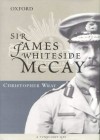Sir James Whiteside McCay: A Turbulent Life
Written by: Christopher Wray,
Oxford University Press, Melbourne, 2002,
ISBN: 9780195515732, 280pp.
Reviewed by: Brigadier John Essex-Clark (Retd)
‘One of the greatest soldiers ever to have served Australia ... greater even than Monash’
So wrote General Brudenell White. This is an honest book that should be read by those who aspire to understand leadership and the pitfalls of egocentricity. It highlights the weaknesses of a strict, dogmatic, non-empathetic and management-oriented leadership style. The book is well worth reading in order to view the life of a man who too often squandered great opportunities through self-aggrandisement rather than teamwork.
The story of Major General Sir James Whiteside McCay KBE, KCMG, CB, by Christopher Wray, is thoroughly researched—a task made more difficult by the fact that McCay burnt all his personal records in a bonfire. The inevitable comparison of McCay and Monash is an invidious one, particularly as the author attempts often to justify the above statement by General Brudenell White. At times, the book becomes more of an apology for McCay’s military leadership weaknesses, rather than an endorsement of his many fine achievements.
Following the career of a driven man who was a lawyer, an artful politician, and ambitious military commander can be interesting. He was, at one time or another, an alderman in local government, a Member of both State and Federal parliaments, and Minister for Defence. As a politician, he was supposed to have ‘a clear and sagacious mind’. McCay was an intensely focused, hard-working and brilliant university student—traits that never left him. Within his legal and political activities, he also managed an army career, reaching the rank of Major General and command of the 5th Division AIF on the Western Front during World War I. He also had been Director of Intelligence. There are good descriptions of the ‘fog of war’, and the flawed planning process and subsequent shambles during the landings and the battles for Krithia on the Gallipoli Peninsula, plus the battles at Fromelles and Flers on the Western Front. The chaos of the march of McCay’s brigade from Tel el Kebir to Ferry Post on the Suez Canal is interesting, as are the descriptions of the well-known lack of tactical commonsense during many of the Australian battles on the Western Front. The maps are imprecise but adequate.
We know that the warfighting culture of British forces in the ‘Great War’ were too often the callous attritional ‘up-and-at-em’ legacies of the previous colonial and European wars. However, it is difficult to excuse the use of any tactics that caused severe casualties, and gained nothing. Many senior British commanders did so for their personal aggrandisement and to gain military kudos. But using the excuse that he was only obeying orders is a poor explanation in the case of a commander such as McCay, to whom was attributed the characteristic of being overly inclined to question orders from his superiors.
Early in the book McCay is described as having ego-idealism—a trait that involves ‘defending one’s ideological position without compromise, even when external criteria strongly indicate that the case will thereby be lost’. Further, the author indicates that McCay lacked ‘luck’ compared with Monash, and that he did not gain the respect and confidence of the men under his command or by those who commanded him. The book touches on the developing power of the media (Keith Murdoch) and the political intrigue and jealousies that plagued the Australian senior officers in London during the war. McCay was unpopular at all levels and was accused of being a demanding leader with a tendency to be a martinet. The worst single criticism he faced, and never quashed, though he was well supported by such as Pompey Elliott and C. E. W. Bean, was his ‘ordering such foredoomed inanities as the Fromelles slaughter in 1917, when he should have refused to do so’. My impression is that McCay was a man imbued with the callous British military leadership culture of that time, and it is perhaps unfair to draw a comparison with today’s softer, inclusive leadership style. However, though he was brave, and wounded twice, he was most unpopular with the men under his command and there are lessons to be learnt from his style—if only to understand what not to do or be.
More than anything I have read recently, this book convinces me that leadership is an art and management is a science or, more significantly, that good ‘management’ is a tool of sound military leadership—not vice versa. Perhaps the book also shows that the same relationship between leadership and management applies equally to political and business leadership. Therefore, to mix these two distinct essentials of command thoughtlessly, or impetuously, can cause failure.
Though not of the same stature as Geoffrey Serle’s magnificent John Monash, Wray’s book deserves to nestle aside it on a bookshelf—if only for historical balance. This must have been a difficult book to write because, for all McCay’s brilliance, bravery, knowledge, dedication, ambition and willpower, he appeared to lack two essential elements of a good leader and commander—commonsense and empathy. Perhaps most significantly, he lacked compassion—recently mentioned by General Peter Cosgrove as an important attribute for commanders to possess.
On the dustcover it states that the book seeks an answer to the enigma of McCay—was he brought down by the failure of others or by his own personality? The militarily experienced reader will most probably plump for the latter, as perhaps does the author in his final sentence.

